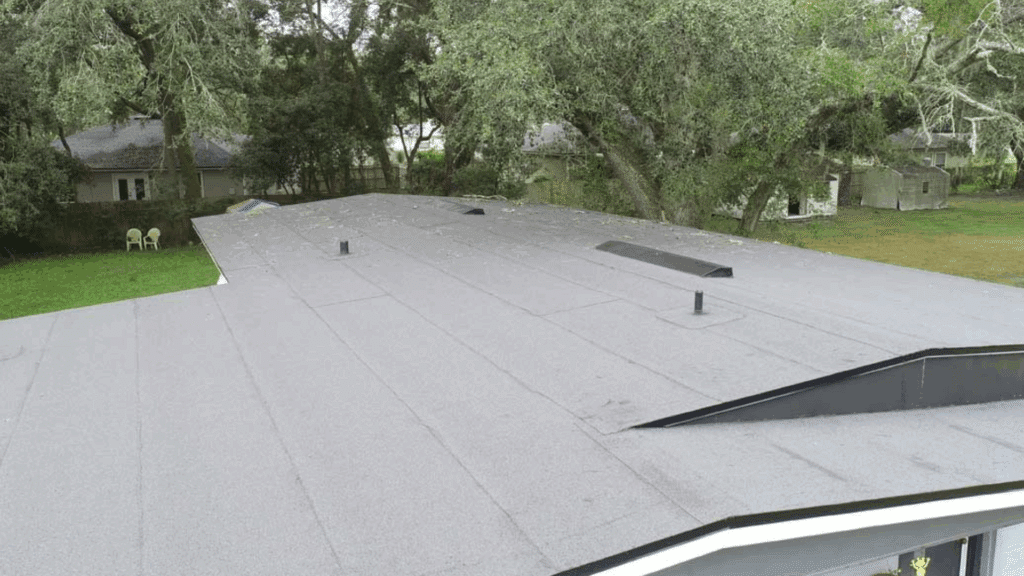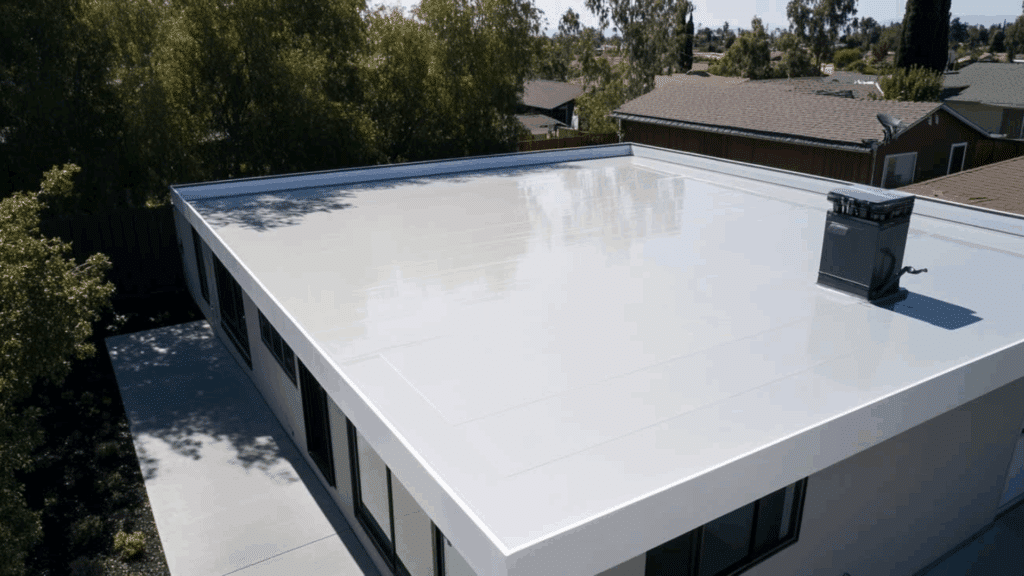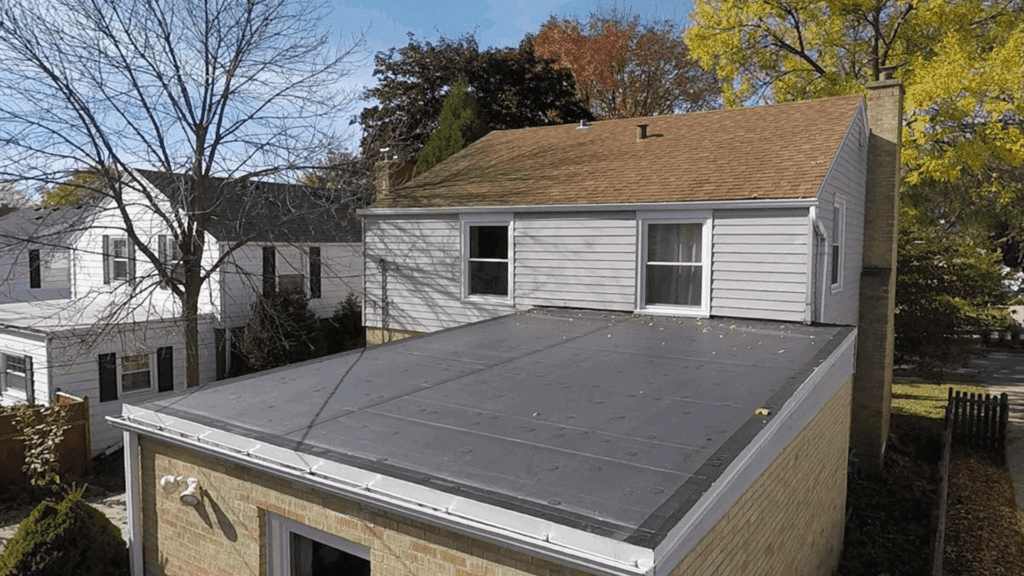If you have a low-slope roof, you know that choosing the right roofing material can be tricky.
You need something that will keep water from pooling and protect your home for years. I understand how important it is to find a reliable, affordable solution.
That’s why I’m here to guide you through the best roofing options for low-slope roofs.
I’ll explain the different materials available, their pros and cons, and how they can fit your budget and needs.
You’ll get all the information you need to make a smart choice that will protect your home and even improve its value.
I’m here to solve your roofing problem by providing clear and simple advice so you don’t have to feel overwhelmed by the options.
Together, we’ll make sure you pick the right material to keep your roof in top shape for a long time.
What is a Low Slope Roof?

A low-slope roof is one that doesn’t have a steep angle, usually with a slope of 4:12 or less.
This means that for every 12 inches of horizontal space, the roof rises only 4 inches or less. These types of roofs are common in certain home designs, like modern or ranch-style houses.
While they can look sleek and stylish, low-slope roofs also come with challenges. The biggest concern is water drainage.
On steeper roofs, rainwater quickly slides off, but with low-slope roofs, water can pool and cause leaks over time.
That’s why it’s so important to choose the right roofing material. The wrong material can lead to bigger issues like water damage and even structural problems.
Understanding the basics of low-slope roofs will help you make the best decision for your home and ensure your roof works effectively.
Importance of Choosing the Right Roofing Material
- Prevent Water Pooling and Leaks: Low-slope roofs are more likely to collect water, which can cause leaks and water damage. Choosing the right material ensures proper drainage and prevents pooling.
- Enhance Roof Lifespan: Durable materials extend the life of your roof, requiring less maintenance and saving money on repairs in the long run.
- Boost Home Value: A well-maintained roof adds curb appeal and can increase your home’s value, making it more attractive to buyers.
Top Roofing Materials for Low-Slope Roofs
Choosing the right roofing material is crucial for low-slope roofs to ensure durability, water resistance, and long-term protection.
1. Modified Bitumen Roofing

Modified bitumen is a popular choice for low-slope roofs, offering durability and water resistance.
It comes in rolls and is applied in layers, often with a heat-welding process. This material is flexible, easy to install, and provides long-lasting protection against leaks.
It’s a great option for homeowners looking for a cost-effective and reliable roofing material, but regular maintenance is needed to ensure its longevity.
2. EPDM (Ethylene Propylene Diene Monomer) Roofing

EPDM is a rubber-based roofing material that provides excellent durability and resistance to extreme weather conditions.
It’s easy to install and maintain, offering long-lasting protection against UV rays and water damage.
EPDM is best installed by professionals to ensure a proper, seamless fit. It’s ideal for residential homes in areas with frequent rainfall or harsh climates.
3. TPO (Thermoplastic Olefin) Roofing

TPO is a lightweight, energy-efficient material with reflective properties that help reduce energy costs by reflecting sunlight.
It is heat-welded to create a waterproof and seamless surface, making it a popular choice for low-slope roofs.
TPO is easy to maintain and offers good resistance to UV rays, bacteria, and chemical exposure, making it a durable choice for homeowners.
4. Standing Seam Metal Roofing

Standing seam metal roofing is a high-quality, long-lasting option for low-slope roofs.
This material is resistant to water, UV rays, and corrosion, providing superior protection. It features vertical panels that are interlocked, reducing the risk of leaks.
Standing seam metal roofs are low maintenance, energy-efficient, and can complement modern home designs, making them a worthwhile investment.
5. Built-Up Roofing (BUR)

Built-Up Roofing, or BUR, consists of multiple layers of bitumen and fabric, creating a sturdy, waterproof barrier for low-slope roofs.
This option is durable and known for its reliability, but it can be heavier and more costly to install.
BUR is often chosen for its long lifespan and ability to withstand harsh weather conditions, making it ideal for homes in challenging climates.
6. PVC Roofing

PVC roofing is a durable and lightweight material that offers excellent waterproofing and resistance to chemicals and UV rays.
It’s especially effective at preventing leaks and is often used in commercial settings but is increasingly seen in residential settings.
PVC is heat-welded to form a strong, seamless surface, making it low-maintenance and ideal for homes with low-slope roofs.
It’s also energy-efficient due to its reflective properties.
Side-by-Side Comparison of Roofing Materials for Low-Slope Roofs
This table breaks down key factors like durability, cost, and energy efficiency to help you make the best choice for your home.
| Roofing Material | Durability | Cost | Maintenance | Energy Efficiency | Ideal for Climate |
|---|---|---|---|---|---|
| Modified Bitumen | High | Affordable | Moderate | Low | Moderate to cold |
| EPDM | Very High | Moderate | Low | Moderate | Rainy and extreme weather |
| TPO | High | Moderate | Low | High | Hot and sunny climates |
| Standing Seam Metal | Very High | High | Low | High | All climates |
| Built-Up Roofing (BUR) | Very High | High | Moderate | Low | Cold and snowy climates |
| PVC | High | High | Low | High | Hot and sunny climates |
Key Factors to Consider When Choosing a Low-Slope Roof Material
When selecting a material for your low-slope roof, it’s important to consider several key factors.
These include the climate, roof usage, budget, energy efficiency, and local regulations to ensure the best fit for your home.
- Climate and Weather Resistance: Choose materials that can withstand local weather conditions, such as heavy rainfall, snow, or intense heat, to ensure your roof remains intact and functional.
- Roof Usage (e.g., Foot Traffic, HVAC Equipment): Consider how the roof will be used. If there will be frequent foot traffic or HVAC equipment, you’ll need a material that can handle the extra weight and wear.
- Budget and Life Expectancy: Balance your budget with the material’s lifespan. Some materials may cost more upfront but last longer, saving you money on repairs over time.
- Energy Efficiency and Reflectivity: Roofing materials that reflect sunlight can help keep your home cooler, reducing energy costs. Look for energy-efficient options that suit your climate.
- Local Building Codes and HOA Requirements: Make sure the roofing material you choose complies with local building codes and any requirements set by your homeowners association (HOA).
Conclusion
Choosing the right material for your low-slope roof is important to protect your home from leaks and water damage.
I’ve shared some of the best options, each with its own benefits, so you can make an informed decision based on your needs and budget.
It’s essential to think about factors like your local climate, how much foot traffic your roof might get, and how long you want the roof to last.
Don’t forget to consider energy efficiency and any local codes that might affect your choice.
No matter which material you pick, investing in the right roofing will keep your home safe and help it last longer.
By understanding these key points, you can feel confident about your decision.
If you’re ever unsure, working with a roofing professional can help guide you to the best solution for your home.

